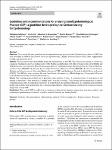Guidelines and recommendations for ensuring Good Epidemiological Practice (GEP): a guideline developed by the German Society for Epidemiology
Hoffmann, Wolfgang
Latza, Ute
Baumeister, Sebastian E.
Brünger, Martin
Buttmann-Schweiger, Nina
Hardt, Juliane
Hoffmann, Verena
Karch, André
Richter, Adrian
Schmidt, Carsten Oliver
Schmidtmann, Irene
Swart, Enno
van den Berg, Neeltje
Objective
To revise the German guidelines and recommendations for ensuring Good Epidemiological Practice (GEP) that were developed in 1999 by the German Society for Epidemiology (DGEpi), evaluated and revised in 2004, supplemented in 2008, and updated in 2014.
Methods
The executive board of the DGEpi tasked the third revision of the GEP. The revision was arrived as a result of a consensus-building process by a working group of the DGEpi in collaboration with other working groups of the DGEpi and with the German Association for Medical Informatics, Biometry and Epidemiology, the German Society of Social Medicine and Prevention (DGSMP), the German Region of the International Biometric Society (IBS-DR), the German Technology, Methods and Infrastructure for Networked Medical Research (TMF), and the German Network for Health Services Research (DNVF). The GEP also refers to related German Good Practice documents (e.g. Health Reporting, Cartographical Practice in the Healthcare System, Secondary Data Analysis).
Results
The working group modified the 11 guidelines (after revision: 1 ethics, 2 research question, 3 study protocol and manual of operations, 4 data protection, 5 sample banks, 6 quality assurance, 7 data storage and documentation, 8 analysis of epidemiological data, 9 contractual framework, 10 interpretation and scientific publication, 11 communication and public health) and modified and supplemented the related recommendations. All participating scientific professional associations adopted the revised GEP.
Conclusions
The revised GEP are addressed to everyone involved in the planning, preparation, execution, analysis, and evaluation of epidemiological research, as well as research institutes and funding bodies.

